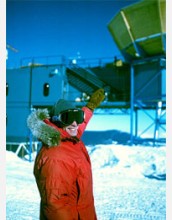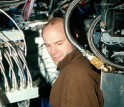News Release 01-038
NSF-Supported Teams Provide New Data on Early Moments of the Universe
Antarctic-based instruments support each other's results

John Carlstrom, dressed in cold-weather gear, points to the DASI detector.
April 29, 2001
This material is available primarily for archival purposes. Telephone numbers or other contact information may be out of date; please see current contact information at media contacts.
Two teams of cosmologists today released new findings about the nature of the universe in its infancy. Their spectacular images of the cosmic microwave background (CMB), taken with instruments operating from Antarctica, reveal the strongest evidence to date for the theory of inflation, the leading model for the formation of the universe.
The announcement represents the first release of data from the Degree Angular Scale Interferometer (DASI), a 13-element ground-based instrument operating since last year at the National Science Foundation (NSF) Amundsen Scott South Pole Station. Scientists also released similar results from further analysis of data from the Balloon Observations of Millimetric Extragalactic Radiation and Geophysics (BOOMERANG) project, obtained in 1998 and first reported last year.
"These spectacular results represent a payback from the significant national investment in research in the polar regions," said Karl Erb, director of the NSF Office of Polar Programs. "The Antarctic environment provides exceptional clarity for astrophysical observations, and the U.S. Antarctic Program provides unmatched support for world-class research."
Both analyses, unveiled at the American Physical Society meetings in Washington, D.C., support the model that the universe experienced a tremendous spurt of growth shortly after the Big Bang. Cosmologists believe the structures that formed in the very first moments of the cosmos left their imprint as a very faint pattern of variations in the temperature of the CMB, the radiation left over from the intense heat that filled the embryonic universe during the initial growth spurt. Some 12-15 billion years later, these temperatures have become detectable from Earth with highly sensitive instruments.
"With these new data, inflation looks very strong," said DASI lead scientist John Carlstrom, professor of astronomy and astrophysics at the University of Chicago. "It's always been theoretically compelling. Now it's on very solid experimental ground."
Multiple teams supported by the National Science Foundation (NSF) have probed the CMB for these minute temperature variations, including the two teams operating from the polar region. Two other teams using instruments in the continental United States also released data.
"This is an outstanding example of how NSF supports multiple scientific projects, leading to rapid, new results," said NSF senior science associate Morris Aizenman. "It took more than a decade to get the initial observations of the cosmic microwave background with the COBE satellite, and in only a few short years, the progress in sharpening those observations has been truly astounding."
The teams used independent methods and two different technologies to obtain detailed observations of the CMB. The observations have provided so much data that new methods had to be invented to analyze them. As the data analyses continue, they are providing precise measurements of parameters that cosmologists have long used to describe the early evolution of the universe, but in the past could only illustrate with models.
NASA's Cosmic Background Explorer (COBE) satellite provided the first detailed images of tiny variations in the CMB radiation in 1992. Last year, the BOOMERANG team published the first high-resolution images of the CMB, obtained with a telescope suspended from a balloon that circumnavigated the Antarctic at an altitude of almost 37 kilometers (120,000 feet). A third team obtained high-resolution images with the Millimeter Anisotropy Experiment Imaging Array (MAXIMA), flown with a high-altitude balloon over the continental United States. The intricate images from the independent projects showed the very beginnings of structure in the universe and provided evidence for the prediction that the universe was "flat," a term that refers to the curvature of space.
The inflation theory also predicted that the imprint of early structures would feature harmonic-like "peaks" in the temperature variations of the CMB. But detection of those features was beyond the ability of the technology until recently.
The results reported at today's meeting by members of BOOMERANG and DASI appear to confirm the predicted peaks. The peaks were observed as variations in the temperature of the CMB as small as 100 millionths of a degree.
MAXIMA data presented at the meeting are consistent with the existence of the peaks, as are the data of a fourth NSF-supported team, using the Cosmic Background Imager (CBI) at the California Institute of Technology. The CBI team reported their findings in the March 1 issue of the Astrophysical Journal.
The DASI, BOOMERANG, MAXIMA, DASI and CBI projects are supported by NSF through NSF Science and Technology Centers, NSF's U.S. Antarctic Program, and individual grants. BOOMERANG and MAXIMA were also supported by NASA's National Scientific Balloon Facility, and BOOMERANG received support from the governments of Italy, the United Kingdom and Canada.
-NSF-
-
John Carlstrom inside the DASI telescope at the South Pole.
Credit and Larger Version
For more information see the individual project websites at:
DASI - astro.uchicago.edu/dasi/
BOOMERANG - cmb.phys.cwru.edu/boomerang
MAXIMA -cosmology.berkeley.edu/group/cmb/index.html
CBI - www.astro.caltech.edu/~tjp/CBI/
For background information on scientific research in Antarctica, see:
www.usap.gov/
www.wff.nasa.gov/~code820/
For background on the cosmic microwave background, see:
http://bit.ly/2doCs2r
Media Contacts
Amber L. Jones, NSF, (703) 292-7740, email: aljones@nsf.gov
Peter West, NSF, (703) 292-7761, email: pwest@nsf.gov
Program Contacts
Morris L. Aizenman, NSF, (703) 292-8807, email: maizenma@nsf.gov
Dennis Peacock, NSF, (703) 292-8033, email: dpeacock@nsf.gov
The U.S. National Science Foundation propels the nation forward by advancing fundamental research in all fields of science and engineering. NSF supports research and people by providing facilities, instruments and funding to support their ingenuity and sustain the U.S. as a global leader in research and innovation. With a fiscal year 2023 budget of $9.5 billion, NSF funds reach all 50 states through grants to nearly 2,000 colleges, universities and institutions. Each year, NSF receives more than 40,000 competitive proposals and makes about 11,000 new awards. Those awards include support for cooperative research with industry, Arctic and Antarctic research and operations, and U.S. participation in international scientific efforts.
Connect with us online
NSF website: nsf.gov
NSF News: nsf.gov/news
For News Media: nsf.gov/news/newsroom
Statistics: nsf.gov/statistics/
Awards database: nsf.gov/awardsearch/
Follow us on social
Twitter: twitter.com/NSF
Facebook: facebook.com/US.NSF
Instagram: instagram.com/nsfgov



